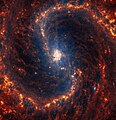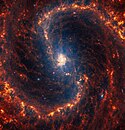NGC 4535
| Galaxie NGC 4535 | |
|---|---|
 | |
| Aufnahme mit dem VLT | |
| AladinLite | |
| Sternbild | Jungfrau |
| Position Äquinoktium: J2000.0, Epoche: J2000.0 | |
| Rektaszension | 12h 34m 20,3s[1] |
| Deklination | +08° 11′ 52″[1] |
| Erscheinungsbild | |
| Morphologischer Typ | SAB(s)c;LINER / HII[1] |
| Helligkeit (visuell) | 9,8 mag[2] |
| Helligkeit (B-Band) | 10,5 mag[2] |
| Winkelausdehnung | 7,1′ × 5′[2] |
| Positionswinkel | 0°[2] |
| Flächenhelligkeit | 13,5 mag/arcmin²[2] |
| Physikalische Daten | |
| Zugehörigkeit | Virgo-Galaxienhaufen LGG 296[1][3] |
| Rotverschiebung | 0.006551 ± 0.000002[1] |
| Radialgeschwindigkeit | (1964 ± 1) km/s[1] |
| Hubbledistanz H0 = 73 km/(s • Mpc) | (85 ± 6) · 106 Lj (26,0 ± 1,8) Mpc [1] |
| Durchmesser | 110.000 Lj |
| Geschichte | |
| Entdeckung | Wilhelm Herschel |
| Entdeckungsdatum | 28. Dezember 1785 |
| Katalogbezeichnungen | |
| NGC 4535 • UGC 7727 • PGC 41812 • CGCG 042-159 • MCG +01-32-104 • IRAS 12318+0828 • 2MASX J12342031+0811519 • VCC 1555 • GC 3080 • H II 500 • Holm 420A • LDCE 0904 NED185 | |
NGC 4535 ist eine Balken-Spiralgalaxie vom Hubble-Typ SAB(s)c im Sternbild Jungfrau auf der Ekliptik, die schätzungsweise 85 Millionen Lichtjahre von der Milchstraße entfernt. Die Entfernungsmessungen basierend auf den Radialgeschwindigkeiten stimmen nicht mit den rotverschiebungsunabhängigen Entfernungsschätzungen von 51 ± 12 Millionen Lichtjahren überein. Sie ist Teil des Virgo-Galaxienhaufens, einer Ansammlung von Galaxien, die alle durch ihre gegenseitige Anziehungskraft zusammengehalten werden.
Weil die Galaxie in kleineren Teleskopen leicht zu übersehen ist, wird sie manchmal "Lost Galaxy" (Verlorene Galaxie) genannt. Dieser Spitzname geht auf einen Artikel des Amateurastronomen Leland S. Copeland aus den 1950er-Jahren zurück.
Das Objekt wurde am 28. Dezember 1785 von dem deutsch-britischen Astronomen Friedrich Wilhelm Herschel entdeckt[4]
- (c) ESA/Hubble, CC BY 4.0Der zentrale Bereich von NGC 4535, aufgenommen mithilfe des Hubble-Weltraumteleskop.
- (c) NASA, ESA, CSA, STScI, J. Lee (STScI), T. Williams (Oxford), PHANGS Team, CC BY 4.0Infrarotaufnahmen mithilfe des James-Webb-Weltraumteleskops
NGC 4535-Gruppe (LGG 296)
| Galaxie | Alternativname | Entfernung/Mio. Lj |
|---|---|---|
| NGC 4482 | PGC 41272 | 79 |
| NGC 4492 | PGC 41383 | 75 |
| NGC 4532 | PGC 41811 | 87 |
| NGC 4535 | PGC 41812 | 85 |
| NGC 4570 | PGC 42096 | 77 |
| NGC 4598 | PGC 42427 | 85 |
| NGC 4612 | PGC 42574 | 76 |
| NGC 4623 | PGC 42647 | 78 |
| IC 3591 | PGC 42108 | 70 |
| IC 3617 | PGC 42348 | 90 |
| PGC 41861 | UGC 7739 | 88 |
| PGC 42230 | UGC 7802 | 77 |
| PGC 42068 | MCG +1-32-111 | 77 |
| PGC 42378 | VCC 1804 | 82 |
Literatur
- König, Michael & Binnewies, Stefan (2019): Bildatlas der Galaxien: Die Astrophysik hinter den Astrofotografien, Stuttgart: Kosmos, S. 149
Weblinks
- astronews.com: Bild des Tages 25. März 2013
- Spektrum.de: Amateuraufnahmen [1]
- Colours of the Lost Galaxy (engl.)
Einzelnachweise
Auf dieser Seite verwendete Medien
(c) NASA, ESA, CSA, STScI, J. Lee (STScI), T. Williams (Oxford), PHANGS Team, CC BY 4.0
This spiral galaxy was observed as part of the Physics at High Angular resolution in Nearby GalaxieS (PHANGS) program, a large project that includes observations from several space- and ground-based telescopes of many galaxies to help researchers study all phases of the star formation cycle, from the formation of stars within dusty gas clouds to the energy released in the process that creates the intricate structures revealed by Webb’s new images.NGC 4535 is 50 million light-years away in the constellation Virgo.Learn more about what can be seen in this vast collection of Webb images here.[Image description: Webb’s image of NGC 4535 shows a densely populated face-on barred spiral galaxy anchored by its central region, which has a light orange haze. The galaxy’s core is centred and connected by an almost vertical bar structure to the galaxy’s two prominent spiral arms, which appear to rotate clockwise, forming an elongated S shape in shades of orange.]
(c) ESA/Hubble, CC BY 4.0
Located in the constellation of Virgo (The Virgin), around 50 million light-years from Earth, NGC 4535 is truly a stunning sight to behold. Despite the incredible quality of this image, taken from the NASA/ESA Hubble Space Telescope, NGC 4535 has a hazy, somewhat ghostly, appearance when viewed from a smaller telescope. This led amateur astronomer Leland S. Copeland to nickname NGC 4535 the“Lost Galaxy” in the 1950s.
The bright colours in this image aren’t just beautiful to look at, as they actually tell us about the population of stars within this barred spiral galaxy. The bright blue-ish colours, seen nestled amongst NGC 4535’s long, spiral arms, indicate the presence of a greater number of younger and hotter stars. In contrast, the yellower tones of this galaxy’s bulge suggest that this central area is home to stars which are older and cooler.
This galaxy was studied as part of the PHANGS survey, which aims to clarify many of the links between cold gas clouds, star formation, and the overall shape and other properties of galaxies. On 11 January 2021 the first release of the PHANGS-HST Collection was made publicly available.Autor/Urheber: ESO, Lizenz: CC BY 4.0
This image depicts the galaxy NGC 4535, in the constellation of Virgo (The Maiden), on a beautiful background full of many distant faint galaxies. Its almost circular appearance shows that we observe it nearly face-on. In the centre of the galaxy, there is a well-defined bar structure, with dust lanes that curve sharply before the spiral arms break from the ends of the bar. The bluish colour of the spiral arms points to the presence of a large number of hot young stars. In the centre, however, older and cooler stars give the bulge of the galaxy a yellower appearance.
This visible image was made with the FORS1 instrument on ESO’s 8.2-metre Very Large Telescope. The galaxy can also be seen through smaller amateur telescopes, and was first observed by William Herschel in 1785. When seen through a smaller telescope, NGC 4535 has a hazy, ghostly appearance, which inspired the prominent amateur astronomer Leland S. Copeland to name it “The Lost Galaxy” in the 1950s.
NGC 4535 is one of the largest galaxies in the Virgo Cluster, a massive cluster of as many as 2000 galaxies, about 50 million light-years away. Although the Virgo Cluster is not much larger in diameter than the Local Group — the galaxy cluster to which the Milky Way belongs — it contains almost fifty times as many galaxies.



